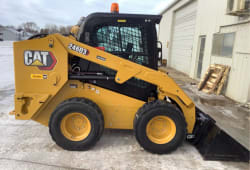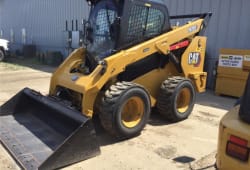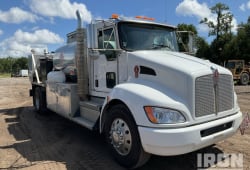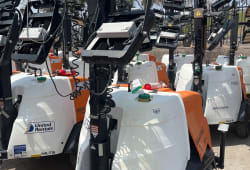Are you Looking to Buy Used Forestry Equipment for Sale?
9 Min read
)
December 21, 2023
In the dynamic realm of forestry, the quest for efficiency and sustainability drives industry players to explore cost-effective alternatives. One such avenue gaining momentum is the purchase of used forestry equipment. Investing in pre-owned machinery can prove to be a strategic move for businesses looking to optimize their operations without breaking the bank. This article delves into the world of used forestry equipment for sale, exploring the benefits, considerations, and the thriving market that connects buyers and sellers in this eco-conscious era.
The Benefits of Opting for Used Forestry Equipment for Sale
Investing in used forestry equipment offers cost savings without compromising quality. It allows access to well-maintained machinery at lower prices, enabling efficient operations while minimizing initial investment. Additionally, buying used equipment often means faster acquisition, reducing downtime and ensuring a quicker start to forestry projects. Moreover, these machines might come with proven performance records, giving buyers confidence in their reliability and functionality.
Cost-efficiency:
Used forestry equipment offers a compelling advantage in terms of cost. For businesses operating on tight budgets or seeking to maximize their return on investment, purchasing pre-owned machinery is a financially astute decision. The significant price difference between new and used equipment allows forestry professionals to allocate resources strategically, unlocking potential savings for other crucial aspects of their operations.
Proven Reliability:
Contrary to misconceptions, used forestry equipment can often be more reliable than expected. Many machines have a proven track record, having weathered the demands of the field. This reliability is a testament to their durability and capability to withstand the challenges of forestry operations. Savvy buyers recognize that a well-maintained, used piece of equipment can seamlessly integrate into their fleet, contributing to increased productivity.
Reduced Depreciation Concerns:
New equipment experiences rapid depreciation, with its value diminishing significantly within the first few years. By opting for used forestry equipment, buyers sidestep the steepest portion of this depreciation curve. This allows for a more stable financial outlook, with the machinery retaining a higher percentage of its original value. This reduced depreciation concern is particularly appealing for businesses looking to maintain a robust balance sheet.
The Market Dynamics of Used Forestry Equipment
The market for used forestry equipment is dynamic, influenced by factors like technological advancements, industry demand fluctuations, and the condition of available machinery. Prices fluctuate based on supply, demand, and the age/condition of the equipment. This market also sees innovations in machinery design, creating a continuous flow of used equipment as newer models emerge. Understanding these dynamics helps buyers make informed decisions, leveraging market trends for optimal purchases.
Diverse Inventory:
The market for used forestry equipment for sale boasts a diverse inventory, catering to the varied needs of industry professionals. From chainsaws and chippers to skidders and harvesters, buyers can find an array of well-maintained machinery. This diversity allows businesses to source equipment that aligns precisely with their operational requirements, fostering a more tailored and efficient approach to forestry management.
Online Platforms and Auctions:
The digital age has transformed the way used forestry equipment is bought and sold. Online platforms and auctions have emerged as popular venues for connecting buyers with sellers, transcending geographical boundaries. These platforms provide a transparent and efficient marketplace, where detailed specifications, condition reports, and pricing information empower buyers to make informed decisions. As a result, the accessibility and convenience of online transactions have become integral to the used forestry equipment market.
Certification and Inspection Standards:
To address concerns about the condition of used forestry equipment, industry standards and certifications have gained prominence. Reputable sellers often subject their machinery to rigorous inspections and adhere to established standards, providing buyers with assurance regarding the equipment's quality and performance. The prevalence of certification programs has contributed to the professionalization of the used forestry equipment market, fostering trust among buyers and sellers alike.
Considerations When Buying Used Forestry Equipment
Several key factors demand consideration when purchasing used forestry equipment. Conducting thorough inspections to assess the machine's condition, maintenance history, and any potential issues is crucial. Evaluating the equipment's compatibility with specific forestry tasks, availability of spare parts, and the reputation of the seller or dealer are equally important. Additionally, considering the total cost of ownership, including maintenance and operational expenses, ensures a cost-effective investment.
Maintenance and Service History:
A crucial aspect of purchasing used forestry equipment is a thorough examination of its maintenance and service history. Comprehensive records detailing routine maintenance, repairs, and part replacements offer insights into the equipment's overall health. Buyers should prioritize equipment with a well-documented history, as it indicates proper care and attention, reducing the risk of unforeseen issues.
Matching Specifications:
Forestry operations are diverse, and equipment requirements vary accordingly. When considering used forestry equipment, it is imperative to match specifications with operational needs. Understanding the specific demands of the forestry tasks at hand ensures that the purchased equipment integrates seamlessly into the existing fleet, contributing to a harmonized and efficient workflow.
Technology and Upgrades:
The pace of technological advancements in the forestry industry is rapid. Buyers of used forestry equipment should assess the potential for technology upgrades and retrofits. Upgradable equipment not only enhances operational efficiency but also extends the lifespan of the machinery. This consideration is pivotal for ensuring that the purchased equipment remains relevant and competitive in the evolving landscape of forestry technology.
Exploring Specific Types of Used Forestry Equipment
The realm of used forestry equipment encompasses various specialized machines like skidders, feller bunchers, delimbers, and chippers, each designed for distinct tasks. Understanding the unique functionalities and optimal use cases for these equipment types is vital. For instance, skidders excel in hauling logs, while feller bunchers efficiently cut and gather trees. Delving into the nuances of each type aids buyers in selecting the right machinery for their specific forestry operations.
1. Chippers and Grinders:
Chainsaws are indispensable tools in forestry, and the used market offers a variety of options. From lightweight models for precision cutting to powerful chainsaws for felling large trees, buyers can find equipment suited to their specific needs. Assessing factors like engine power, bar length, and ergonomic features ensures a chainsaw aligns with the demands of the job.
2. Chippers and Grinders:
Used chippers and grinders play a crucial role in processing timber waste. Buyers can explore different models with varying capacities and features to find equipment that efficiently converts branches and logs into valuable wood chips. Examining factors such as engine horsepower, feed capacity, and maintenance history is essential for making an informed purchase.
3. Skidders and Forwarders:
For timber extraction in challenging terrain, skidders and forwarders are essential. The used market offers a range of options, from compact skidders for smaller operations to heavy-duty forwarders for large-scale logging. Buyers should consider factors such as load capacity, traction, and articulated vs. non-articulated designs to select equipment that aligns with their specific logging conditions.
4. Harvesters:
Harvesters revolutionize the logging process by efficiently felling, delimbing, and bucking trees in a single operation. In the used market, buyers can find harvesters with varying cutting capacities and advanced harvesting heads. Evaluating factors like cutting diameter, fuel efficiency, and automation features ensures that the chosen harvester meets the efficiency and productivity requirements of the forestry operation.
Environmental Considerations and Sustainability
Opting for used forestry equipment aligns with sustainability goals by extending the lifespan of machinery and reducing manufacturing demand. By reusing equipment, the industry minimizes its environmental footprint, decreasing resource consumption and waste generation associated with producing new machines. Additionally, adopting well-maintained, older equipment that meets modern efficiency standards contributes to eco-friendly forestry practices, promoting a more sustainable approach within the industry.
Environmental Impact of Buying Used:
Choosing used forestry equipment aligns with sustainability goals by minimizing the environmental impact associated with manufacturing new machinery. The carbon footprint of used equipment is significantly lower, contributing to a more eco-friendly approach to forestry operations. Buyers can take pride in the fact that their decision to opt for used machinery supports a circular economy and reduces overall resource consumption.
Adopting Circular Economy Practices:
The circular economy principles emphasize extending the life cycle of products through reuse and recycling. Purchasing used forestry equipment for sale is a tangible manifestation of these principles, contributing to a more circular and sustainable forestry industry. By giving pre-owned machinery a second life, businesses actively participate in reducing waste and conserving resources.
Conclusion:
In conclusion, the market for used forestry equipment for sale presents a myriad of opportunities for businesses seeking to optimize their operations while maintaining fiscal prudence. The benefits of cost-efficiency, proven reliability, and reduced depreciation concerns make used forestry equipment an attractive option. The market dynamics, facilitated by online platforms and certification standards, contribute to a transparent and efficient marketplace.
As businesses navigate the decision-making process, careful considerations, such as assessing maintenance records, matching specifications, and evaluating upgrade possibilities, are essential. By embracing the value and potential of used forestry equipment, industry professionals can unlock a sustainable and cost-effective pathway to meet the demands of modern forestry management. In a landscape where resource optimization is paramount, the market for used forestry equipment emerges as a key player in fostering both economic and ecological sustainability.

Caleb Woods is an experienced content specialist and an editor at Boom & Bucket, blending his journalism background with expertise in the heavy equipment industry. He delivers engaging, informative content to help professionals stay informed and make smarter decisions in the machinery market.














